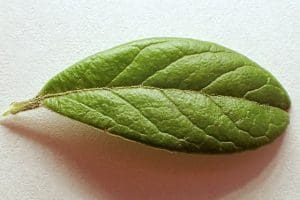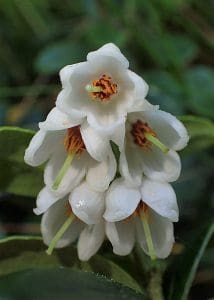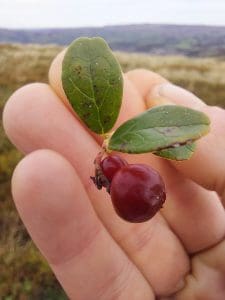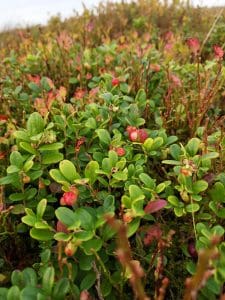Cowberry / Summer / Autumn / Edible
Cowberry is a brilliant little edible fruit that isn’t heavily harvested in the UK, however in the nordic countries this one is commercially harvested from the wild and can be found in lots of products and menus, it’s lovely in Jam, fresh or pickled.
Common Names
Lingonberry, Partridgeberry, Mountain Cranberry.
Botanical Name
Vaccinium vitis-idaea
Scientific Classification
– Kingdom:Plantae
– Order:Ericales
– Family:Ericaceae
Physical Characteristics if Cowberry
A low growing shrub, it’s often found growing around heather and bilberries – fantastic two-for-one on berries when you find it with the lovely bilberry!
Leaves
Cowberry leaves are evergreen, elliptical, and they grow alternately along the stem. They have a glossy texture, are dark green in colour, and have slightly toothed edges.

Flowers
The flowers are small and bell-shaped, typically pinkish-white. They form in clusters and have an urn-like appearance. Flowering during late spring to early summer.

Fruit
The berries are small, round, and red and look like small cranberries. They ripen in late summer to autumn and are known for their slightly tart taste.

Habitat
Cowberry thrives in heathland areas, particularly in acidic soils and is common on moors in northern England.
Known Hazards
There are no significant hazards associated with this plant but some studies show that prolonged consumption or large amounts of cranberry, which are closely related, might increase the risk of kidney stone formation.
Could be Confused with
The closest look a like is Cranberry (Vaccinium oxycoccos) but this is also edible.
Edible Uses
The berries of cowberry are edible and can be used as cranberry alternatives. They can be eaten raw but are pretty sharp so much better cooked down with a little sugar or honey.
In Sweden and many Ikea stores, traditional Swedish meatballs are served with lingonberry jam alongside boiled or mashed potatoes and gravy sauce.
Notes on Herbal Uses
Cowberries have been dubbed a superfood due to their nutritional profile and antioxidant content. Though more research is needed, studies suggest that they may promote healthy gut bacteria, weight control, heart health, and blood sugar control among other benefits.
In traditional herbal medicine Cowberry leaf tea is used to treat kidney problems and urinary tract infections. Fruits and fruit are recommended to treat urinary tract infections, prostate and kidney problems, overweightness, hyperglycaemia, and high blood pressure.
Extra notes from the Foragers
In Russia and Northern Europe, there are several folktales explaining how Lingonberries became an evergreen species with life-giving nutrients. Legend has it that a swallow carried living water in its beak. The bird felt pride in being able to help others and planned on sprinkling the water on people to grant them immortality. When the swallow was flying one day, it was stung by a wasp. As a reaction to the pain, the bird opened its beak, spilling the water over three plants- Lingonberries, Cedar, and Pine trees.








